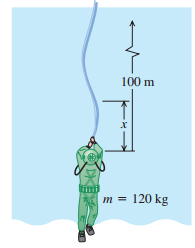A deep-sea diver is suspended beneath the surface of Loch Ness by a 100-m-long cable that is
Question:
Figure P15.84:

The diver thinks he sees something moving in the murky depths and jerks the end of the cable back and forth to send transverse waves up the cable as a signal to his companions in the boat.
(a) What is the tension in the cable at its lower end, where it is attached to the diver? Do not forget to include the buoy-ant force that the water (density 1000 kg/m3) exerts on him.
(b) Calculate the tension in the cable a distance x above the diver. The buoyant force on the cable must be included in your calculation.
(c) The speed of transverse waves on the cable is given by v = ˆšF/µ (Eq. 15.13). The speed therefore varies along the cable, since the tension is not constant. (This expression neglects the damping force that the water exerts on the moving cable.) Integrate to find the time required for the first signal to reach the surface.
Step by Step Answer:

University Physics with Modern Physics
ISBN: 978-0321696861
13th edition
Authors: Hugh D. Young, Roger A. Freedman, A. Lewis Ford





